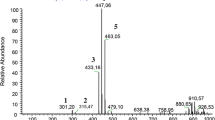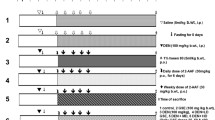Abstract
Isoflavones are phenolic compounds widely distributed in plants and found in a high percentage in soybeans. They have important biological properties and are regarded as potential chemopreventive agents. The aim of this study was to verify the preventive effect of two soy isoflavones (genistein and daidzein) by a micronucleus assay, analysis of GST activity, and real-time RT-PCR analysis of GSTa2 gene expression. Mutagens of direct (doxorubicin) and indirect (2-aminoanthracene) DNA damage were used. Hepatoma cells (HTC) were treated with genistein or daidzein for 26 h at noncytotoxic concentrations; 10 μM when alone, and 0.1, 1.0 and 10 μM when combined with genotoxic agents. The micronucleus test demonstrated that both isoflavones alone had no genotoxic effect. Genistein showed antimutagenic effects at 10 μM with both direct and indirect DNA damage agents. On phase II enzyme regulation, the current study indicated an increase in total cytoplasmic GST activity in response to genistein and daidzein at 10 μM supplementation. However, the mRNA levels of GSTa2 isozymes were not differentially modulated by genistein or daidzein. The results point to an in vitro antimutagenic activity of genistein against direct and indirect DNA damage-induced mutagenicity.




Similar content being viewed by others
References
Akiyama T, Ishida J, Nakagawa S, Ogawara H, Itoh SWN, Shibuya N, Fukami Y (1987) Genistein, a specific inhibitor of tyrosine-specific protein kinases. J Biol Chem 262:5592–5595
Antunes LMG, Araujo MCP (2000) Mutagenicidade e antimutagenicidade dos principais corantes para alimentos. Rev Nutr 13:81–88
Bellini MF, Angeli JPF, Matuo R, Terezan AP, Ribeiro LR, Mantovani MS (2006) Antigenotoxicity of Agaricus blazei mushroom organic and aqueous extracts in chromosomal aberration and cytokinesis block micronucleus assays in CHO-k1 and HTC cells. Toxicol in Vitro 20:355–360
Bhamre S, Sahoo D, Tibshirani R, Dill DL, Brooks JD (2010) Gene expression changes induced by genistein in the prostate cancer cell line LNCaP. Open Prost Cancer J 3:86–98
Bradford MM (1976) A rapid sensitive method for the quantification of microgram quantities of protein utilizing the principle of protein dye binding”. Anal Biochem 72:248–254
Chang HC, Churchwell MI, Delclos KB, Newbold RR, Doerge DR (2000) Mass spectrometric determination of Genistein tissue distribution in diet-exposed Sprague-Dawley rats. J Nutr 130:1963–1970
Chen WF, Huang MH, Tzang CH, Yang M, Wonga MS (2003) Inhibitory actions of genistein in human breast cancer (MCF-7) cells. Biochim Biophys Acta 1638:187–196
Chodon D, Ramamurty N, Sakthisekaran D (2007) A Preliminary studies on induction of apoptosis by genistein on HepG2 cell line. Toxicol in Vitro 2:887–889
Choi EJ, Kim GH (2008) Daidzein causes cell cycle arrest at the G1 and G2/M phases in human breast cancer MCF-7 and MDA-MB-453 cells. Phytomedicine 15:683–690
Choi JN, Dockyu K, Hyung KC, Kyung MY, Jiyoung K, Choong HL (2009) 2'-hydroxylation of genistein enhanced antioxidant and antiproliferative activities in MCF-7 human breast cancer cells. J Microbiol Biotechnol 19(11):1348–1354
deVere White RW, Tsodikov A, Stapp EC, Soares SE, Fujii H, Hackman RM (2010) Effects of a high dose, aglycone-rich soy extract on prostate-specific antigen and serum isoflavone concentrations in men with localized prostate cancer. Nutr Cancer 62:1036–1043
Di Virgilio AL, Iwami K, Wätjen W, Kahl R, Degen GH (2004) Genotoxicity of isoflavones genistein, daidzein and equol in V79 cells. Toxicol Lett 151:151–162
Fenech M (2000) The in vitro micronucleus technique. Mutat Res 455:81–95
Foti P, Erba D, Riso P, Spadafranca A, Criscuoli F, Testolin G (2005) Comparison between daidzein and genistein antioxidant activity in primary and cancer lymphocytes. Arch Biochem Biophys 433:421–427
Gardner CD, Oelrich B, Liu JP, Feldman D, Franke AA, Brooks JD (2009) Prostatic soy isoflavone concentrations exceed serum levels after dietary supplementation. Prostate 69:719–726
Hayes JD, Pulford DJ (1995) The glutathione-S-transferase supergene family: regulation of GST and the contribution of the isoenzymes to cancer chemoprotection and drug resistance part I. Crit Rev Biochem Mol Biol 30:445–520
Hernandez-Montes E, Pollard SE, Vauzour D, Jofre-Montseny L, Rota C, Rimbach G, Weinberg PD, Spencer PE (2006) Activation of glutathione peroxidase via Nrf1 mediates genistein’s protection against oxidative endothelial cell injury. Biochem Biophys Res Commun 346:851–859
Houghton P, Fang R, Techatanawat I, Teventon G, Hylands PJ, Lee CC (2007) The sulphorhodamine (SRB) assay and other approaches to testing plants extracts and derived compounds for activities related to reputed anticancer activity. Methods 42:377–387
Janning P, Schuhmacher US, Upmeier A, Diel P, Michna H, Degen GH, Bolt HM (2000) Toxicokinetics of the phytoestrogen daidzein in female DA/Han rats. Arch Toxicol 74:421–430
Jemnitz K, Geza V, Torok G, Toth E, Vereczkey L (2004) Comparative study in the Ames test of benzo[a]pyrene and 2-aminoanthracene metabolic activation using rat hepatic S9 and hepatocytes following in vivo or in vitro induction. Mutagenesis 19:245–250
Klein CB, King AA (2007) Genistein genotoxicity: critical considerations of in vitro exposure dose. Toxicol Appl Pharmacol 224:1–11
Kulling SE, Metzler M (1997) Induction of micronuclei, DNA strand breaks and HPRT mutations in cultured Chinese hamster V79 cells by the phytoestrogen coumoestrol. Food Chem Toxicol 35:605–613
Kulling SE, Rosenberg B, Jacobs E, Metzler M (1999) The phytoestrogens coumoestrol and genistein induce structural chromosomal aberrations in cultured human peripheral blood lymphocytes. Arch Toxicol 73:50–54
Lee R, Kim YJ, Lee YJ, Chung WH (2004) The selective effect of genistein on the toxicity of bleomycin in normal lymphocytes and HL-60 cells. Toxicology 195:87–95
Linseisen J, Piller R, Hermann S, Chang-Claude J (2004) Dietary phytoestrogen intake and premenopausal breast cancer risk in a German case-control study. Int J Cancer 110:284–290
Manson MM, Ball HWL, Barrett MC, Clark Hl, Judah DJ, Williamson G, Neal GE (1997) Mechanism of action of dietary chemoprotective agents in rat liver: induction of phase I and II drug metabolizing enzymes. Carcinogenesis 18:1729–1738
Marcarini JC, Tsuboy MSF, Luiz RC, Ribeiro LR, Hoffmann-Campo CB, Mantovani MS (2011) Investigation of cytotoxic, apoptosis-inducing, genotoxic and protective effects of the flavonoid rutin in HTC hepatic cells. Exp Toxicol Pathol 63:459–465
Maubach J, Bracke ME, Heyerick A, Depypere HT, Serreyn RF, Mareel MM, De Keukeleire D (2003) Quantitation of soy-derived phytoestrogens in human breast tissue and biological fluids by high-performance liquid chromatography. J Chromatogr B Analyt Technol Biomed Life Sci 784:137–144
Miltyk W, Craciunescu CN, Fischer L, Jeffcoat RA, Koch MA, Lopaczynski W, Mahone C, Jeffcoat RA, Crowell J, Paglieri J, Zeisel SH (2003) Lack of significant genotoxicity of purified soy isoflavones (genistein, daidzein, and glycitein) in 20 patients with prostate cancer. Am J Clin Nutr 77:875–882
Moon YJ, Wang X, Morris ME (2006) Dietary flavonoids: effects on xenobiotic and carcinogen metabolism. Toxicol in Vitro 20:187–210
Mosmann T (1983) Rapid Colorimetric assay for cellular growth and survival: application to proliferation and cytotoxicity assays. J Immunol Meth 65:55–56
Naithani R, Huma LC, Moriarty RM, Mccormick DL, Mehta RG (2008) Comprehensive review of cancer chemopreventive agents evaluated in experimental carcinogenesis models and clinical trials. Curr Med Chem 15:1044–1071
Oliveira RJ, Ribeiro LR, Silva AF, Matuo F, Mantovani MS (2006) Evaluation of antimutagenic activity and mechanisms of action of b-glucan from barley, in CHO-k1 and HTC cell lines using the micronucleus test. Toxicol in Vitro 20:1225–1233
Pfaffl MW (2001) A new mathematical model for relative quantification in real-time RT–PCR. Nucleic Acids Res 29:2002–2007
Pfaffl MW, Horgan GW, Dempfle L (2002) Relative expression software tool (REST) for group-wise comparison and statistical analysis of relative expression results in real-time PCR. Nucleic Acids Res 30:e36
Polívková Z, Langová M, Šmerák P, Bártová J, Bárta I (2006) Antimutagenic Effect of Genistein. Czech J Food Sci 24(3):119–126
Pool-Zobel B, Veeriah S, Bohmer FD (2005) Modulation of xenobiotic metabolizing enzymes by anticarcinogens – focus on glutathione S-transferases and their role as targets of dietary chemoprevention in colorectal carcinogenesis. Mutat Res 591(1–2):74–92
Pugalendhi P, Manoharan S, Panjamurthy K, Balakrishnan S, Nirmal MR (2009) Antigenotoxic effect of genistein against 7,12-dimethylbenz[a]anthracene induced genotoxicity in bone marrow cells of female Wistar rats. Pharmacol Rep 61:296–303
Quiles JL, Huertas JR, Battino M, Mataix J, Ramirez-Tortosa M (2002) Antioxidant nutrients and adriamycin toxicity. Toxicology 180:79–95
Record IR, Jannes M, Dreosti IE, King RA (1995) Induction of Micronucleus Formation in Mouse Splenocytes by the Soy Isoflavone Genistein In Vitro but not In Vivo. Food Chem Toxicol 33:919–922
Rufer CE, Kulling SE (2006) Antioxidant Activity of Isoflavones and Their Major Metabolites Using Different in Vitro Assays. J Agric Food Chem 54:2926–2931
Safford B, Dickens A, Halleron N, Briggs D, Carthew P, Baker V (2003) A model to estimate the oestrogen receptor mediated effects from exposure to soy isoflavones in food. Regul Toxicol Pharmacol 38:196–209
Singh MS, Michael M (2009) Role of xenobiotic metabolic enzymes in cancer epidemiology. Methods Mol Biol 472:243–264
Waters MD, Brady AL, Stack HF, Brockman HE (1990) Antimutagenic profiles for some model compounds. Mutat Res 238:57–85
Weisstein EW Least Squares Fitting–Exponential.” From MathWorld–A Wolfram Web Resource. http://mathworld.wolfram.com/LeastSquaresFittingExponential.html. Acess 07/02/2011
Wiegand H, Wagner AE, Boesch-Saadatmandi C, Kruse HP, Kulling S, Rimbach G (2009) Effect of Dietary Genistein on Phase II and Antioxidant Enzymes in Rat Liver. Cancer Genomics Proteomics 6:85–92
Wiseman H, Casey K, Bowey EA, Duffy R, Davies M, Rowland IR et al (2004) Influence of 10 wk soy consumption on plasma con-centrations and excretion of isoflavonoids and on gut microflora in healthy adults. Am J Clin Nutr 80:692–699
Wu HJ, Chan WH (2007) Genistein protects methylglyoxal-induced oxidative DNA damage and cell injury in human mononuclear cells. Toxicol in Vitro 21:335–342
Acknowledgments
The authors thank National Council of Scientific and Technological Development (CNPq), Coordination for the Improvement of Superior Level (CAPES) and Araucaria Foundation for the Support of Scientific and Technological Development of Parana—Brazil.
Conflict of interest
The authors declare that there are no conflicts of interest.
Author information
Authors and Affiliations
Corresponding author
Rights and permissions
About this article
Cite this article
Lepri, S.R., Luiz, R.C., Zanelatto, L.C. et al. Chemoprotective activity of the isoflavones, genistein and daidzein on mutagenicity induced by direct and indirect mutagens in cultured HTC cells. Cytotechnology 65, 213–222 (2013). https://doi.org/10.1007/s10616-012-9476-8
Received:
Accepted:
Published:
Issue Date:
DOI: https://doi.org/10.1007/s10616-012-9476-8




